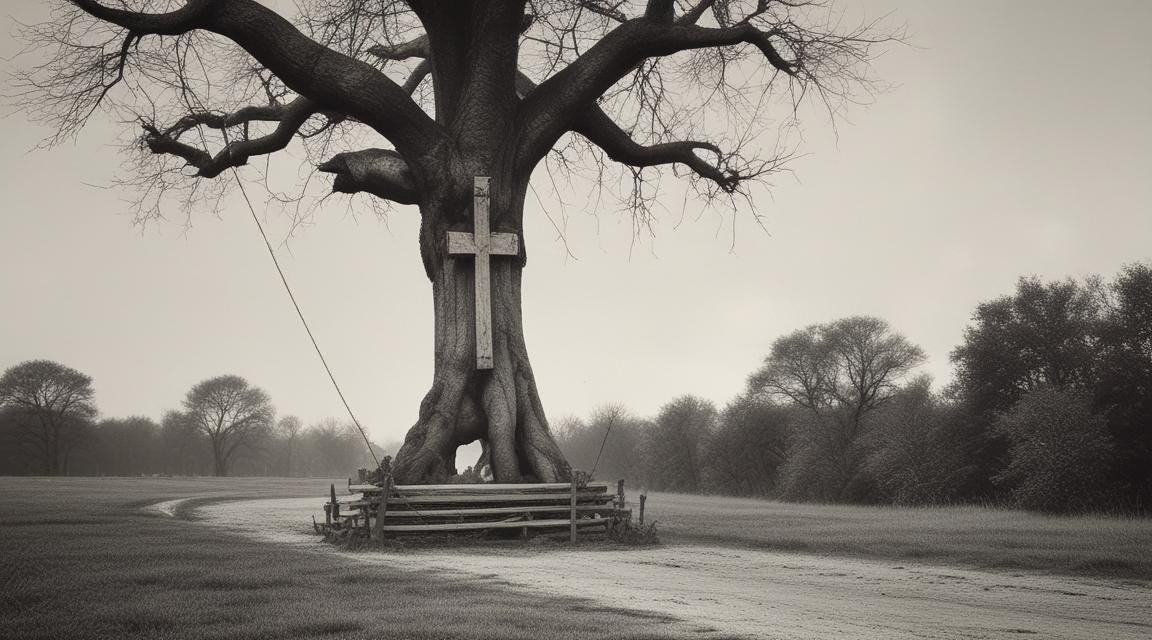Via Iesu
The way of Jesus Through the Cross
I really do like the idea of the via media or middle way. The concept is good if we existed upon a straight line continuum of existence. But as it is, we exist in a multifaceted universe where freedom and agency alter the road ahead of us every moment. Dr. Sam Powell mentioned beliefs do not lie on a continuum either. Rather, beliefs can appear to be radically different from one another, yet actually be almost the same. (His example was Nazi Germany and Stalinist Russia.) But something more jarring hit me this week, and that made me sit back and think on the via media.
The something is that two people who have a deep disagreement with theology and practice have both made statements about how lacking the via media can be. To be fair, one disagrees because of what I believe is a misunderstanding. But the other, Dr. Thomas Jay Oord, has issues with the via media because it has become much of what the other person thinks it is. The phrase no longer describes the concept as it should be, but has become the very idea of compromise in forging a middle way which simply borrows enough to avoid the extremes. But what if the extremes are in a circle as Dr. Powell describes? Then there is no extreme to avoid, and we get embroiled in the constant pull to be part of the circle.
Faced with a conundrum, I toyed with phrases and ideas. That is when I remembered a conversation with a friend who had been a student of a young Dr. Craig Keen while discussing various Nazarene theologians and their approaches to theology. The friend mentioned that the retired Dr. Keen whom I met online often spoke into situations by saying, well yes, but have you looked at the way of Jesus, the way of the broken body of Christ on a cross? I had my term; via Iesu the way of Jesus. I originally thought if the way of Christ, but that Latin ends up as via Christi and I imagine my wife would not enjoy having her name linked to a theological concept being worked out in my head. Craig Keen has also mentioned via per crucem or the way through the cross. That is excellent as well, but I believe if properly understood, that via Iesu is the way of the cross as it contains the totality of the Jesus event.
(Full access at 8AM CDT 8-3-2024)
The via Iesu is centered in the person of Jesus. Being centered, it finds itself in the liminal space of the circle mentioned above. Rather than holding tensions between two extremes, those following the via Iesu may find themselves fending off attacks from all around. While attacks are not a full measure of being faithful, those attacks show the danger of a Jesus centered ethos. This is not a path of least trouble or of combination, but a fresh path being forged in faith by people not afraid to invite others into relationship with an expansive yet deeply personal God. Being centered, the via Iesu has freedom of movement around the circle while being moored to the truth of Jesus. This is a way of improvisational faith, theology, and praxis. This is not a MacGuyver improvisation, but one in which we deeply trust one another and God so that we can work out the path ahead in love and grace.
The via Iesu is an invitation to see what, who, and where the Spirit of God is working. It is an invitation to be a cross shaped people who are not quick to anger, be outraged, or place others outside the reach of love. More than that, the via Iesu makes a space for the worship of sinners as Jelly Roll speaks about on the album Whitsett Road or within the theology of the cross present in Diane Leclerc and Brent Peterson’s The Back Side of the Cross. As we travel this path, the Spirit is improvising with us finding new music from old and forging an ethics of cross shaped compassion and love.
There is an intense and lasting hope in the via Iesu because the circle that may attack from any point cannot contain the way centered in Jesus. Instead, that circle is broken open at every point that the way of Jesus breaks out of the assumed boundaries of those living in the extremes. The via Iesu helps to temper the forces that would drive us to embrace outrage, fear, and destruction as ways to drive decisions. Rather, the way of Jesus is one of peace, love, and hope. The via Iesu is a way of freedom, because the truth will set us free after all. The truth is present in the person of Jesus and in the way we are able to “do justice, love kindness, and walk humbly with [our] God.” (Micah 6:8b NRSVue)
This is your invitation to embrace the via Iesu by following the one who gave himself over to violence so that violence would lose its very power. I can’t promise it is an easy path, but it will have a lot fewer thorns.



